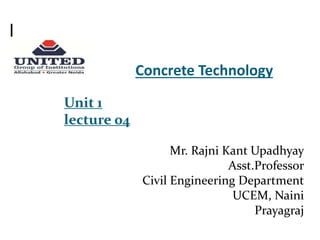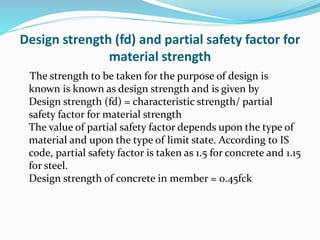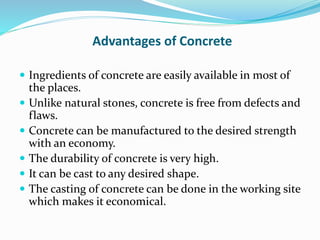Concrete unit 1 (4)
- 1. Concrete Technology Unit 1 lecture 04 Mr. Rajni Kant Upadhyay Asst.Professor Civil Engineering Department UCEM, Naini Prayagraj
- 2. Ingredients of Concrete Portland Cement Aggregate â sand, gravel, crushed rock Water Admixtures â when necessary
- 3. Cement ï In the most general sense of the word, a cement is a binder, a substance that sets and hardens independently, and can bind other materials together ï Cement used in construction is characterized as hydraulic or non-hydraulic. Hydraulic cements (e.g., Portland cement) harden because of hydration, chemical reactions that occur independently of the mixture's water content; they can harden even underwater or when constantly exposed to wet weather.
- 4. Physical Properties of Cement ï Fineness ï Soundness ï Consistency ï Strength ï Setting time ï Heat of hydration ï Loss of ignition ï Bulk density ï Specific gravity (Relative density
- 5. 1. Grades of concrete ï Concrete is known by its grade which is designated as M15, M20 etc. in which letter M refers to concrete mix and number 15, 20 denotes the specified compressive strength (fck) of 150mm cube at 28 days, expressed in N/mm2. ï Thus, concrete is known by its compressive strength. M20 and M25 are the most common grades of concrete, and higher grades of concrete should be used for severe, very severe and extreme environments.
- 6. 2. Compressive strength of concrete Like load, the strength of the concrete is also a quality which varies considerably for the same concrete mix. Therefore, a single representative value, known as characteristic strength is used
- 7. 3. Characteristic strength of concrete ï It is defined as the value of the strength below which not more then 5% of the test results are expected to fall (i.e. there is 95% probability of achieving this value only 5% of not achieving the same) Characteristic strength of concrete in flexural member ï The characteristic strength of concrete in flexural member is taken as 0.67 times the strength of concrete cube.
- 8. Design strength (fd) and partial safety factor for material strength The strength to be taken for the purpose of design is known is known as design strength and is given by Design strength (fd) = characteristic strength/ partial safety factor for material strength The value of partial safety factor depends upon the type of material and upon the type of limit state. According to IS code, partial safety factor is taken as 1.5 for concrete and 1.15 for steel. Design strength of concrete in member = 0.45fck
- 9. 4. Tensile strength of concrete The estimate of flexural tensile strength or the modulus of rupture or the cracking strength of concrete from cube compressive strength is obtained by the relations ï fcr = 0.7 fck N/mm2. The tensile strength of concrete in direct tension is obtained experimentally by split cylinder. It varies between 1/8 to 1/12 of cube compressive strength.
- 10. 5. Creep in concrete ï Creep is defined as the plastic deformation under sustained load. Creep strain depends primarily on the duration of sustained loading. According to the code, the value of the ultimate creep coefficient is taken as 1.6 at 28 days of loading.
- 11. 6. Shrinkage of Concrete ï The property of diminishing in volume during the process of drying and hardening is termed Shrinkage. It depends mainly on the duration of exposure. If this strain is prevented, it produces tensile stress in the concrete and hence concrete develops cracks.
- 12. 7. Modular ratio ï Short term modular ratio is the modulus of elasticity of steel to the modulus of elasticity of concrete. ï Short term modular ratio = Es / Ec ï Es = modulus of elasticity of steel (2 x 10 5 N/mm2) ï Ec = modulus of elasticity of concrete (5000 x SQRT(fck) N/mm2) ï As the modulus of elasticity of concrete changes with time, age at loading etc the modular ratio also changes accordingly. Taking into account the effects of creep and shrinkage partially IS code gives the following expression for the long term modular ratio. ï Long term modular ratio (m) = 280/ (3fcbc) ï Where, fcbc = permissible compressive stress due to bending in concrete in N/mm2.
- 13. 8. Poissonâs ratio Poissonâs ratio varies between 0.1 for high strength concrete and 0.2 for weak mixes. It is normally taken as 0.15 for strength design and 0.2 for serviceability criteria.
- 14. 9. Durability of concrete ï Durability of concrete is its ability to resist its disintegration and decay. One of the chief characteristics influencing durability of concrete is its permeability to increase of water and other potentially deleterious materials. ï The desired low permeability in concrete is achieved by having adequate cement, sufficient low water/cement ratio, by ensuring full compaction of concrete and by adequate curing.
- 15. 10. Unit weight of concrete ï The unit weight of concrete depends on percentage of reinforcement, type of aggregate, amount of voids and varies from 23 to 26 kN/m2. The unit weight of plain and reinforced concrete as specified by IS:456 are 24 and 25 KN/m3 respectively.
- 16. Uses of concrete ï Many structural elements like footings, columns, beams, chejjas, lintels, roofs are made with R.C.C. Cement concrete is used for making storage structures like water tanks, bins, silos, bunkers etc. Bridges, dams, retaining walls are R.C.C. structures in which concrete is the major ingradient.ing storage structures like water tanks, bins, silos, bunkers etc.
- 17. Advantages of Concrete ï Ingredients of concrete are easily available in most of the places. ï Unlike natural stones, concrete is free from defects and flaws. ï Concrete can be manufactured to the desired strength with an economy. ï The durability of concrete is very high. ï It can be cast to any desired shape. ï The casting of concrete can be done in the working site which makes it economical.
- 18. Advantages of Concrete contâĶ. ï The maintenance cost of concrete is almost negligible. ï The deterioration of concrete is not appreciable with age. ï Concrete makes a building fire-safe due to its noncombustible nature. ï Concrete can withstand high temperatures. ï Concrete is resistant to wind and water. Therefore, it is very useful in storm shelters.
- 19. Disadvantages of Concrete ï Compared to other binding materials, the tensile strength of concrete is relatively low. ï Concrete is less ductile. ï The weight of compared is high compared to its strength. ï Concrete may contains soluble salts. Soluble salts cause efflorescence.
- 20. THANK YOU



















